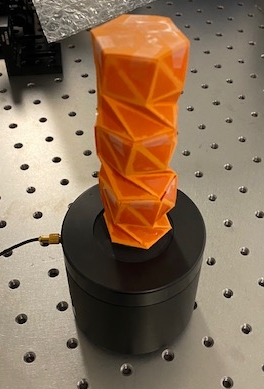
Figure 1
Figure 2

Team 71
Team Members |
Faculty Advisor |
Ashmika Gupta |
Dr. Osama Bilal Sponsor Other |
sponsored by
Uconn, Dr. Osama Bilal
Deployable Origami Based Structures and Their Potential Applications in Engineering
This project explores deployable origami-based structures for vibration control. Origami-based structures have been shown to be effective at attenuating vibrations due to their unique geometry. Their capabilities stem from their unique nonlinear stiffness which is a direct result of their geometry. They are also cost efficient and easy to fabricate as they can be transformed from 2D sheets into 3D configurations. Our lab is called Wave engineering for extreme and intelligent materials (We-xite), where we perform research on metamaterials and meta-structures . These are uniquely designed structures which obtain their unique properties due to their geometry rather than their chemical composition. In this project, I consider an origami design known as the Kresling pattern. The pattern is made out of a 2D flat sheet and can be folded into a three-dimensional column. The stiffness of the studied structure is modeled using a nonlinear finite element method to accurately simulate the nonlinear behavior of the structure. This model was then used to explore the response of the column to vibrational excitation both numerically and experimentally. A numerical tool was created in MATLAB in order to plot dispersion curves and a frequency response function for the purpose of extracting the band gap (range of frequencies that cannot propagate through the structure) of the system. The experimental samples were fabricated using different 2D material sheets (such as thin plastic and construction paper) and the pattern was cut precisely using an automated mechanical cutter. The flat pattern was then folded and assembled into a column with each panel being reinforced with a UV curable resin. This sample was then excited using a mechanical shaker in order to generate an experimental frequency response function. Experimental results were then compared with the numerical results. This project presents the findings from the numerical and experimental vibrational analysis of the
